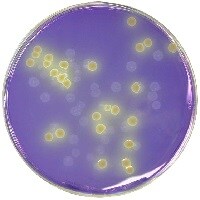 Description
Description
Clostridium perfringens is a Gram-positive, anaerobic, rod-shaped bacterium from the Clostridium genus. It is both heat-resistant and cold-tolerant, surviving in conditions with little or no oxygen. C. perfringens is found widely in the environment in soil, rotting vegetation and marine sediment, as well as in the intestinal tract of humans and animals.
The bacteria can form endospores, capable of surviving adverse conditions for long periods of time. When favorable conditions are encountered, the endospores germinate rapidly; C. perfringens has the shortest generation time, 6.3 minutes, reported for any organism.
There are five toxigenic strains of C. perfringens (A-E) based on the type of toxin they produce (alpha-, beta-, epsilon- and iota-); strains A and C are pathogenic to humans. Type A and occasionally types B, C, D and E contain the cpe gene, which produce an enterotoxin, CPE on cell lysis following sporulation. This can cause gastroenteritis. Infection with bacteria producing alpha and theta exotoxins results in tissue damage (gas gangrene), usually as the result of deep wound contamination.
Foods can easily become contaminated with C. perfringens during preparation. Thorough cooking usually destroys the bacteria but the spores will survive. This can be problematic when the cooked product is allowed to cool slowly at room temperature or stored with inadequate refrigeration as the spores can then germinate. Most cases of food poisoning seen following ingestion of C. perfringens are gastroenteritis, characterized by abdominal cramps and diarrhea. This is usually self-limiting but can be serious in elderly, debilitated or immunocompromised patients.
Enteritis necroticans, a severe and often fatal form of the disease, is uncommon in North America. It arises from eating contaminated pork and causes abdominal pain, vomiting and diarrhea. In severe cases intestinal necrosis develops, causing peritonitis and septicemia.
Incidence
Cl. perfringens is the third most common cause of food poisoning in the US and the UK. According to CDC reports, C. perfringens infection was responsible for 10% of all reported cases of foodborne illness in the U.S. during 2011. More than 950,000 illnesses were reported resulting in 26 deaths.
Infective Dose
The infective dose of C. perfringens isn’t accurately known. However, ingestion of large numbers of vegetative bacteria or their spores (>106 spores or cells per gram of food) produces enough CPE to cause disease.
Foods Affected
Foods affected include meat and poultry products, especially those that are cooked and allowed to cool at ambient temperature before consumption. In addition, other foods such as vegetables and fish can also be a source of food poisoning if they have been cooked then left at room temperature for too long before eating. The bacteria multiply as the food cools slowly; prompt refrigeration to below 40⁰F prevents spores from developing. It’s worth noting that C. perfringens also survives desiccation and can also be present in dried products.
Learn more about other common and less common food microbes in our series of fact sheets.
References
- United States Food and Drug Administration – Bad Bug Book: Foodborne pathogenic microorganisms and natural toxins handbook [pdf]
- Federal food safety information at Food Safety.gov
- Centers for Disease Control and Prevention fact sheet on Clostridium perfringens.
- Public Health Canada food safety fact sheet


Leave a Reply